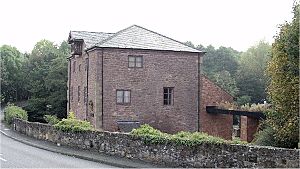River Clywedog facts for kids
Quick facts for kids River Clywedog |
|
|---|---|

The Clywedog near Bersham
|
|
| Native name | Afon Clywedog |
| Country | Wales |
| Town | Wrexham |
| Physical characteristics | |
| Main source | near Gwynfryn, Wrexham County Borough 320 m (1,050 ft) 53°3′46.078″N 3°6′20.527″W / 53.06279944°N 3.10570194°W |
| River mouth | confluence with River Dee, near Sutton, Isycoed, Wrexham County Borough 14 m (46 ft) 53°1′10.985″N 2°52′56.905″W / 53.01971806°N 2.88247361°W |
| Basin features | |
| Tributaries |
|
The River Clywedog is a cool river found in the Wrexham area of Wales. For a long time, people have used this river for many things. It helped water crops and powered big machines in factories. Today, it's a peaceful place perfect for walking and learning about nature and history. The river starts west of Wrexham and flows into the larger River Dee about four miles southeast of the town.
Contents
Where Does the River Clywedog Flow?
The River Clywedog begins its journey in the hills west of a village called Minera. After flowing through Minera, it turns and heads southeast. It passes by several places like Coedpoeth, Bersham, and Rhostyllen.
Passing Through Erddig Country Park
The river also flows through the beautiful Erddig Country Park. Then, it turns east, just south of Wrexham. You can even walk along the river bank all the way from Minera to Wrexham!
Joining the River Dee
After passing the Wrexham industrial area, the Clywedog river meets up with the River Dee. This meeting point is close to the border between England and Wales.
What Is the History of the River Clywedog?
The River Clywedog has a rich history, especially during the 1700s and early 1800s. It was a very busy place!
How Water Power Changed the Area
During this time, there were 17 watermills along the river. These mills used the power of the flowing water to do many jobs. Some mills prepared cloth, while others ground corn and malt for food. There were even paper mills!
Big waterwheels used the river's power to blow air into iron furnaces at Bersham. They also helped power machines that lifted things and pumped water in lead mines. The river was like a giant engine for the local industries.
The Industrial Revolution and the River
As the Industrial Revolution began, many workers moved to the Wrexham area. They came to work in the growing coal mines, lead mines, and ironworks. The river's flat areas had always been good for farming. To feed all the new people, more corn mills were built, and forests were cleared to grow more crops.
Later, in the late 1800s and 1900s, new steam power took over from water power. This meant factories no longer needed to be right next to the river. New technology and cheaper goods from other places led to a slow decline in the industries around the river.
The River Today: Nature and Trails
Today, the Clywedog river has returned to a more natural state. It's now a wonderful place for wildlife to live, and for people to relax and go for walks. Many of the old industrial buildings and the land around them have become museums, visitor centers, and country parks.
You can visit places like Minera Lead Mines, the Nant Mill Visitor Centre, Bersham Heritage Centre and Ironworks, and Erddig. There's even a special trail, about 7 miles (11 km) long, that follows the river. It's called the Clywedog Trail. It starts at the Minera Lead Mines and ends at Kings Mills, letting you explore the history and nature of the area.
Images for kids






